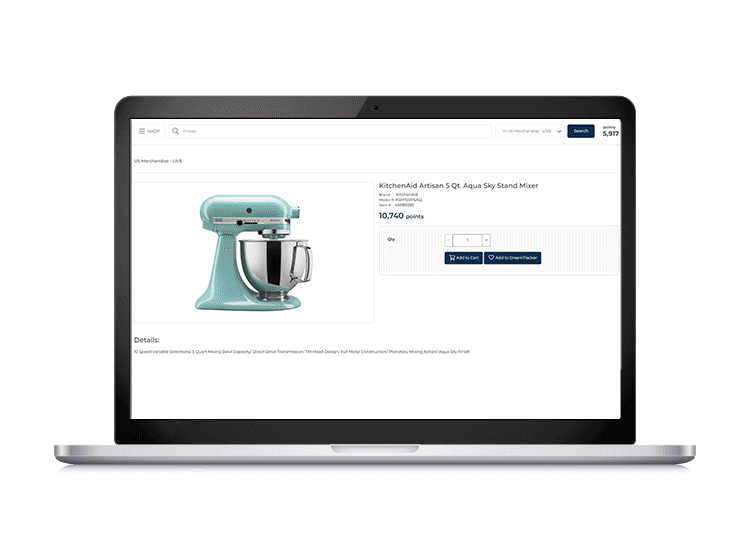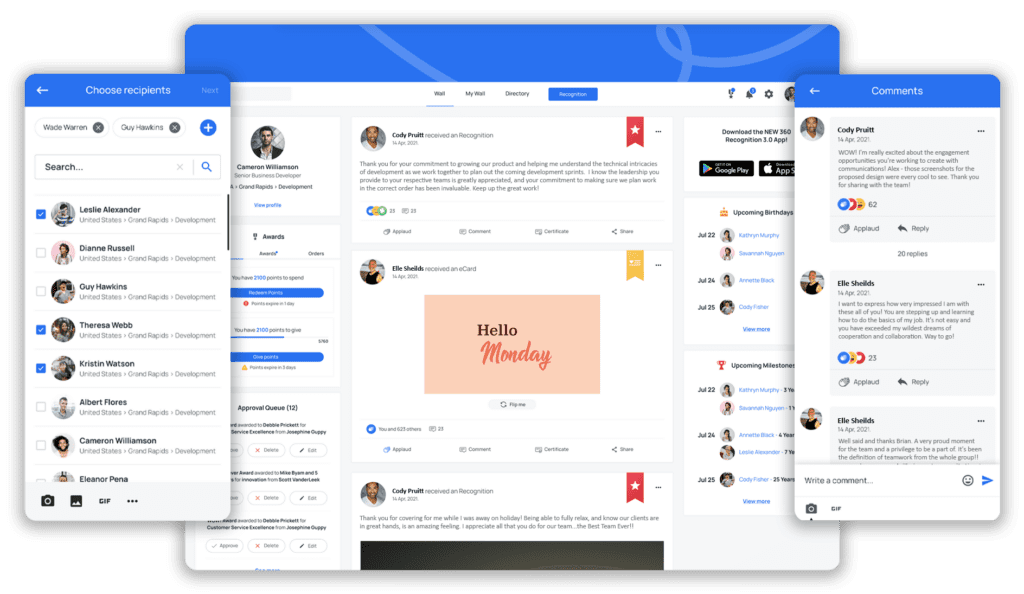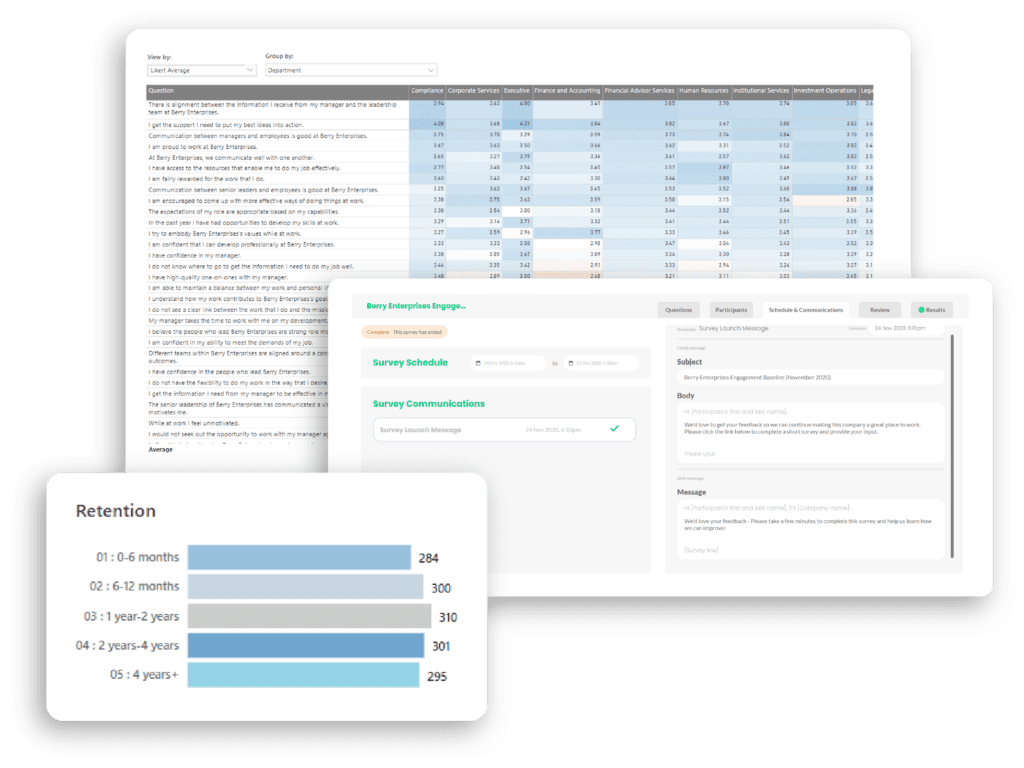October 4, 2023

It's a common misconception that corporations are prosperous because of the products and services they offer. But in reality, a business is only successful if its employees are happy and engaged.
If your workers are not inspired by what they do, they will not do it well — at least not for long.
Research shows that companies with engaged employees are more profitable than their competitors.
A Gallup meta-analysis on employee engagement shows that businesses with highly engaged employees achieve 21% higher profitability. They also experience 17% higher productivity than their disengaged counterparts.
So what's the secret to keeping your team motivated and engaged?
While there's no silver bullet answer, research has shown that employee recognition is an effective strategy for boosting overall employee engagement.
Creating an employee recognition program that works for your company and culture doesn't have to be complicated, but it does take commitment.
Below we outline why rewards and recognition are important and give 9 tips for creating a rewards and recognition program.
Reward and Recognition in the Workplace: Why Is It Important?
Having an employee recognition program is important for many reasons. Below, we walk through some of the key reasons why employee recognition and rewards is essential:

Boosts Morale:
Recognizing and appreciating employees for their hard work and contributions boosts their morale and job satisfaction.
When employees feel valued and appreciated, they are more likely to be invested in their work and motivated to perform at their best.
Increases Motivation:
Employee recognition and rewards can serve as a powerful motivator when executed effectively. This can take the form of incentives programs, choice-based rewards, and more.
Having motivated employees can lead to increased productivity and overall higher-quality work.
Improves Retention:
Employees who feel recognized, appreciated, and rewarded are more likely to stay with their current employer. Research has found that 63% of employees who feel recognized are unlikely to look for a new job.
High employee turnover can be costly and disruptive, so recognizing and retaining top talent is critical for the stability and success of an organization.
Enhances Engagement:
Recognized employees tend to be more engaged in their work. A study by Quantum Workplace found that when employees believe they’ll be recognized for their work, they’re nearly 3 times more likely to be highly engaged.
They are also more likely to take ownership of their tasks, show initiative, and contribute positively to the workplace culture.

Fosters a Positive Culture:
Employee recognition contributes to the development of a positive company culture. When employees in an organization are looking for opportunities to give recognition and say thanks, it builds a culture of humility and gratitude.
Such a culture can lead to better teamwork, collaboration, and communication among employees.
Encourages Desired Behaviors:
Recognition can be used to reinforce behaviors and actions that align with company values and goals.
When employees are rewarded for demonstrating the desired behaviors, it helps in shaping the organizational culture.
Increases Productivity:
Employees who feel recognized and appreciated tend to be more focused and productive.
They are less likely to experience burnout or disengagement, leading to improved overall employee performance.
Strengthens Relationships:
Employee recognition can strengthen the relationship between employees and their managers or peers. It fosters a sense of trust and camaraderie within the team.

Promotes Innovation:
Recognized employees are often more willing to share ideas and take calculated risks, as they feel psychologically safe and supported by the organization.
This can lead to innovation and continuous improvement.
Attracts Top Talent:
Companies known for their employee recognition programs are often more attractive to job seekers. A positive reputation for recognizing and valuing employees can help in recruiting top talent.
Demonstrates Appreciation:
Employee recognition programs are a way for leaders and managers to express their appreciation for the hard work and dedication of their teams.
It shows that the organization values its employees as individuals.
Employee rewards and recognition is essential for boosting employee morale and motivation while also contributing to a positive workplace culture, improved retention rates, and enhanced productivity.
Recognizing employees for their contributions is a win-win for both employees and the organization as a whole.

How to Create a Meaningful Recognition and Reward Strategy
Now that we've covered some of the core benefits of employee rewards and recognition in the workplace, let's dive into eight steps you can take to build a successful recognition strategy.
1. Build a Foundation
Creating a foundation is the first step to building an impactful employee reward and recognition program. You can think of this foundation as the platform on which you will build your strategy.
Because there are a range of employee recognition platforms available on the market today, it's important for companies to choose which one works best for their specific needs.
Be sure you're building the right foundation for your employee recognition program by:
- Identifying your key business objectives.
- Defining what success looks like.
- Determining how you will recognize people in alignment with your company goals.
- Establishing where rewards can play an important role in driving results forward.
This is where an online social recognition program can be useful. Turning recognition digital means employees and leaders can give and receive recognition from anywhere at any time.
Recognition platforms, like Terryberry's, are able to streamline the recognition process so you never miss a recognizable moment.
These platforms can also house your employee rewards program, allowing for a seamless experience.
Award employees points to redeem for merchandise on an online store, or offer choices for more traditional employee rewards, like plaques, custom jewelry, and more.

2. Get Leadership Buy-In
A reward and recognition program is only as strong as the support behind it, which is why executive buy-in is essential - especially at the beginning.
Employees need to see that employee recognition isn't the latest corporate trend, and instead is genuinely the foundation of your company's culture.
And while employees will need to take part in recognition, manager adoption is critical. Data from Terryberry has shown that companies with managers who recognize more often, have employees who recognize more as well.
Help persuade leadership buy-in by highlighting tangible benefits of a recognition program like talent retention, increased employee engagement, boosted employee satisfaction, and an overall positive impact on the company's bottom line.
Furthermore, if you'd like recognition to be engrained as one of your company values and culture, you'll need people from every level to get involved and participate.
While it's true that manager-led recognition is important and impactful, but it's not the only type of recognition that matters.
Encourage employees to engage in peer-to-peer recognition to help gain company-wide buy-in. Sometimes peers are the ones who see employee achievements that managers miss, making peer recognition all the more impactful.
Peer recognition also helps employees feel connected to their company's culture by demonstrating a core company value on a regular basis.

RELATED: Peer Recognition: What Is It and What Are the Benefits?
3. Give Meaningful Recognition Often
A critical aspect of employee recognition is commitment to giving recognition often. Giving employee recognition needs to be a regular and consistent part of your strategy.
In fact, the goal is to recognize people for their contributions and accomplishments as often as possible so that they consistently feel valued and appreciated.
A Gallup poll found that employees should be recognized at least once per week, yet another survey found employees reported an average of 50 days since they last felt recognized in any way at work.
This discrepancy shows a notable disconnect between what employees value and what employers are typically offering.
The key, however, isn't just saying thank you. In order for recognition to be effective at building a positive environment where employees want to work, it shouldn't just be nice - it needs to be meaningful too.
4. Incorporate Employee Rewards
An important aspect of employee recognition is incorporating a reward program into your strategy.
You may think that monetary rewards are the most important part of any great recognition program.
While money is nice to have, it is not the only thing that matters. Non-monetary rewards are just as valuable, especially when tied to your company's culture.
For example, you could give employees time off with pay or paid leave, but you can also recognize them with more personal experiences like tickets to a sporting event or a luxurious spa treatment.
Recognition should tie back to the employee's interests and passions for it to make an impact.

5. Get Creative
Rewarding employees doesn't have to cost a lot of money - in fact, you may not need to give a monetary reward at all.
So as you're creating your employee recognition program, don't overlook the power of non-cash rewards.
Here are some unexpected employee reward examples to get your creativity flowing:
- Go for a team outing somewhere unique, like an escape room, paintball, or axe throwing.
- If someone went above and beyond during a difficult time at work (i.e. during layoffs), send flowers or host an afternoon tea party in his/her honor.
- Gift deserving employees with performance rewards, like plaques, digits, or custom jewelry.
- An employee who has been working hard on a project could be rewarded with extra paid time off.
- If you have a social recognition platform, award your employee with extra points for them to spend as they please.

RELATED: 10 Employee Recognition Ideas
6. Celebrate Accomplishments
Celebrating successes (no matter how big or small) is an essential part of any company's culture. A simple surprise donuts and coffee one morning just to say thank you, can be surprisingly impactful.
This isn't to say treats and parties should take the place of other forms of recognition, like giving public recognition.
But instead, opting to recognize employees with small gestures can be a nice additional way to say thank you and show your team that you notice their work.

RELATED: 22 Employee Rewards and Recognition Ideas for Your Program
7. Improve Processes
As a leader, you know that continually improving processes is necessary for making your team more efficient.
For example, you may find some members of your team are being recognized much more than others simply because they're more outgoing.
Continuously improving your recognition program ensures it's working its best for everyone.
But it can be difficult to know where to start or how much to change. However, once you break it down into three actionable steps, it becomes less daunting:
- Identify a Process for Improvement
Start by identifying a process that could use improvement. Which processes are causing friction among your employees? - What is causing unnecessary work for your workers and their teammates? These processes are prime candidates for improvement.
- Find a Viable Solution for the Process
Once you have identified a process that needs attention, it is time to identify a solution for it. Start by talking with people who have worked on the process before (if they are still part of your team). - They may have insights into how it could run more smoothly in the future. Furthermore, they will appreciate the chance to contribute their opinions.
- Take Action
Gather employee feedback through anonymous surveys about possible improvements and put together an action plan. This plan should outline specific steps toward implementation and set goals for meeting those benchmarks over time (i.e., every quarter). - This will help keep everyone accountable for progress on improving processes at work—and make sure no one gets left behind along the way.

8. Set Specific, Measurable, Attainable, and Timely Goals
When setting goals, make sure they're SMART - specific, measurable, attainable, and timely. If your goal is to increase employee engagement, you'll need to define what that specifically looks like to you.
Does it mean less turnover? Higher productivity? Lower absenteeism? Maybe it's all of these and more.
Then determine how you'll measure this progress. It may be measurable with hard data, or it may be more subjective, like improved morale.
This may require pulse surveys to track, or some other form of tracking metric.
Ensure your goals are attainable, as well. You may want zero turnover, but that's likely not realistic. Instead, maybe your goal looks like reducing turnover from 20% to 18%.
And lastly, make sure you're establishing a timeframe for these goals to occur. It may be quarterly, semi annually, annually, etc.
This will give you a clear snapshot of change to look back and reference for years to come.

RELATED: What is an Employee Engagement Survey? And Why Should You Care?
9. Stick with It
Incorporating a recognition strategy will take some time to be fully engrained into your company's culture, so be sure to stick with it.
An effective recognition program takes commitment, dedication, and company-wide participation - But once you've built a culture of recognition, it will be worth the wait.

Recognize Your Team's Contributions with an Effective Reward and Recognition Strategy
Reward and recognition is a powerful way to motivate and engage employees, but it is also a commitment. Building a successful program takes planning and tweaking over time. When you are starting, keep it simple.
It never hurts to get your team involved if you are unsure where to start. Ask employees what they would like to receive as rewards, or how they would like to be recognized for their accomplishments.
When employees know that they will receive the rewards and recognition they expect, their work efforts are likely to increase.
Whether you are creating a new program or revamping the one you have, we hope these tips help you create a reward strategy that brings out the best in your employees.
Is your business seeking in-depth guidance on implementing an easy-to-use recognition program? Terryberry can help.
Start Building an Rewards and Recognition Strategy Today
Terryberry provides solutions to help drive employee satisfaction through effective employee engagement. These solutions include:
Pulse Survey Software:
Be Heard is an employee engagement survey solution that's designed to enhance your employee experience while fueling business performance.

Service Awards and Performance Awards:
Recognize and reward employees based on years of service awards, anniversaries, or performance.
Social Recognition:
Empower your employees and managers to recognize their peers and celebrate successes with an easy-to-use social recognition application.
Feedback and Communication:
Unlock improved feedback and communications with employee and customer feedback solutions.
Wellness Programs:
We make it easy to run wellness programs and activity challenges that increase engagement, expand corporate health, and build team camaraderie.
Contact Us
Ready to learn more? Schedule a demo with our team to get a hands-on walkthrough of how Terryberry can transform the culture of your workplace.

